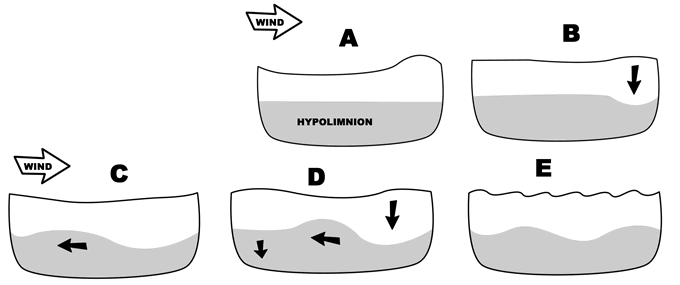The Weird World of Waves
Underwater waves - a.k.a. Seiches
When the wind blows on a lake, you can see waves form on the surface. This is caused by the wind actually moving the water from one place to another. Why doesn’t all of the water in a lake end up in a pile on the downwind side? It’s because the water/wave eventually falls down as gravity takes over. If a lake is large enough and the wind blows for long enough, there can be an awful lot of water falling down. In these cases you can actually get waves underwater. These waves are called internal gravity waves, or internal seiches (“saysh-ez”).
Internal seiches can only form on a stratified lake. A lake stratifies when the water down deep cools so much that it stops mixing with the warmer water nearer the surface. The depth at which this layer occurs is largely a function of light penetration, so in clearer lakes the “hypolimnion” (hypo- under, limnion- lake), or colder underwater layer, will be deeper. If you’ve ever swum in a small green lake, you have probably felt the water get quite cold near your feet. Most likely that’s the hypolimnion. In murkier lakes, the light can’t get in very far to warm the water, so the colder hypolimnion is close enough to the surface to feel with your feet.
On large lakes, if the wind blows in the same direction for long enough, the surface water will want to head toward the downwind side of the lake (A in figure below). When it gets there, it can’t just hang out. Gravity wants the surface of the lake to be flat, so the water falls into the lake. This creates an abundance of the warmer surface water at the downwind end. The hypolimnion is compressed to make room for the warm water (B in figure). Of course that cold water in the hypolimnion needs somewhere to go also! Conveniently, the warm surface water just left the upwind end of the lake. That means that there’s some elbow room at that end. Now the hypolimnion is leaning toward the upwind end of the lake (C in figure).
Well, gravity works under the water too, and cold water is heavier. That’s why it’s down near the bottom in the first place. So the hypolimnion needs to be flat, just like the surface. As the hypolimnion flattens out, its water rushes downward (D in figure). But the wind is still blowing, so there’s more cold water on the way! If the wind keeps blowing, there will be multiple waves formed underwater. These internal waves are longer than surface waves and can be 30 feet or more tall (E in figure). When the wind stops blowing, the internal seiche waves will eventually stop too.
It’s a weird world of waves and it gets even weirder when you start adding in things like the Coriolis force, (the effect caused by the rotation of the earth). But let’s not go there, my head starts to spin just thinking about it.

